Biography
Interests
Shimon Shatzmiller
Department of Chemical Sciences, Ariel University, 40700 Ariel, Israel
*Correspondence to: Dr. Shimon Shatzmiller, Department of Chemical Sciences, Ariel University, 40700 Ariel, Israel.
Copyright © 2021 Dr. Shimon Shatzmiller. This is an open access article distributed under the Creative Commons Attribution License, which permits unrestricted use, distribution, and reproduction in any medium, provided the original work is properly cited.
The Israeli Ministry of Health's extended epidemiological team that examined the relationship between the phenomenon and the vaccine included 3 professional teams: Team 1 - Public Health Experts from the Division of Epidemiology, Team 2 - Experts from the National Center for Disease Control and Team 3 - Experts from the Academy (Tel Aviv University, Haifa University and Technion). The three teams of experts performed an in-depth epidemiological examination and worked in combination, as part of the process of analyzing the disease follow-up data and findings. The teams' conclusion: There is a likelihood of linking the vaccine and the phenomenon among young men aged 30-16. The relationship is even stronger among 19- 16 year olds, relative to other ages. It also shows that the relationship weakens with increasing age. In most cases, it is a mild illness that passes within a few days.
Children who develop the rare complication after COVID-19 known as Multisystem [2] Inflammatory Syndrome in Children, or MIS-C, are at high risk for heart problems that may make it difficult for the heart to pump blood effectively for weeks after thought. After recovering, according to a new study by doctors at the Children's Hospital in Michigan.
One of the most dangerous targets of the COVID-19 viral infection is the human heart. We have reported
on many circumstances in which the heart infected and its function damaged [3a-e].
More than 165 million people have received at least one dose of the COVID-19 vaccine in the United States, and the CDC continues to monitor the safety of COVID-19 vaccines in any health problem that occurs after the vaccine.
Since April 2021, there have been increased reports of systemic adverse events (VAERS) in cases of myocarditis - known as myocarditis and pericarditis - that occurred after the COVID-19 (Pfizer-BioNTech and Moderna) mRNA vaccine in the United States.
Given the number of vaccine doses given, these reports are rare and reported after the COVID-19 mRNA vaccine (Pfizer-BioNTech and Moderna), especially in adolescents and young adults.
CDC and its partners are actively monitoring these reports by reviewing medical records, learning more about what happened, and seeing any connection to the COVID-19 vaccine.
Most patients who received treatment responded well to medicine and rest and felt better quickly
There have been cases reported to VAERS:
Especially among adolescent men and young adults aged 16 and over
More often after receiving the second dose of one of these two COVID-19 vaccines than after the first dose
Usually, within a few days after COVID-19 vaccination
Patients can generally return to their normal daily activities after their symptoms improve, and they should talk to their doctor about returning to exercise or sports.
The CDC continues to recommend the COVID-19 vaccine to anyone 12 years of age and older, given the greater risk of COVID-19 disease and related, perhaps serious, complications.
Immunization is the best way to help protect yourself and your family from COVID-19 [3f-i].
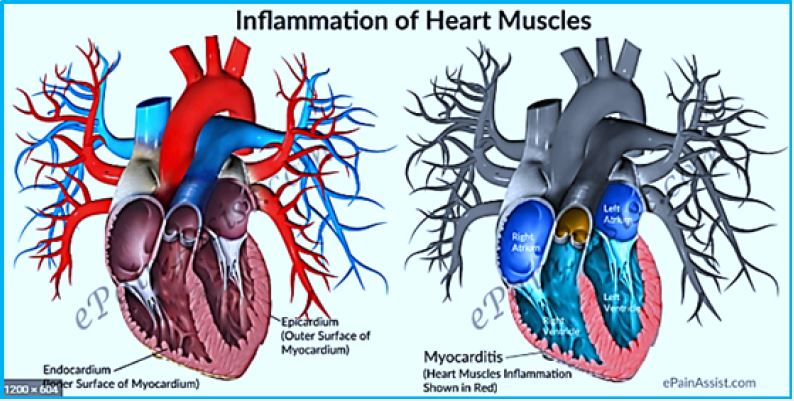
Types of Myocarditis (credit ref [4])
Myocarditis is an inflammation of the heart muscle, and pericarditis is an inflammation of the heart's outer lining. In both cases the body's immune system causes inflammation in response to an infection or other cause. Learn more about the heart muscle and the external symbol of the heart.
Last weekend, the US Centers for Disease Control and Prevention (CDC) warned health care professionals. They monitored the Vaccine Event Reporting System (VAERS) and the Vaccine Safety Linkage System (VSD) in cases of young people who develop rare heart - heart muscle complications after receiving the COVID-19 vaccine manufactured by Pfizer-BioNTech or Moderna. The Vaccine Safety Working Group (VaST) of the CDC Advisory Committee on Vaccines (ACIP) examines several dozen cases of myocardial infarction reported in adolescents and young adults: more often in men rather than women; More frequently after the second dose and not the first dose of Pfizer-BioNTech or Moderna vaccine; And usually appears within four days of vaccination.
The advantages of the COVID-19 vaccination outweigh by far the rare and possible risk of heart-related complications. This is including myocarditis or myocarditis infections.
Acute Respiratory Syndrome-Coronavir-2 (SARS-CoV-2) is a challenge that is unparalleled for the global healthcare community. Respiratory involvement is the primary clinical manifestation of COVID-19, ranging from mild illness such as influenza to severe pneumonia, and acute respiratory distress syndrome [5].
The primary mechanism for SARS-CoV-2 infection is a viral binding to the membrane-bound form of enzyme 2 that converts angiotensin (ACE2) by a protein expressed in the viral coat, called SPIKE (protein S) followed by its application by the serine. Protease TMPRSS2 mediated virus absorption. ACE2 is a membrane-associated peptidase that is expressed in all tissues but is mainly represented in the lungs, heart, vessels, kidneys, brain and intestines.
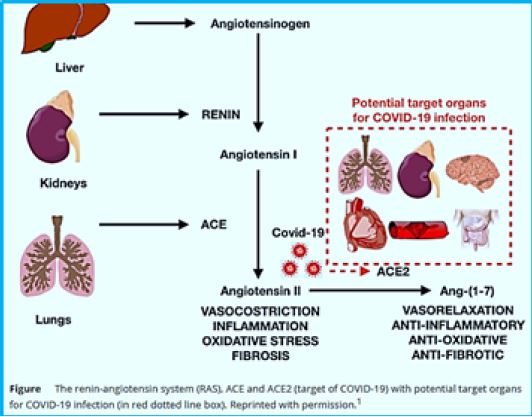
A year and a half since COVID-19 virus was isolated in the city of Wuhan (China). The riddle of how the virus first emerged remains a mystery.
Nobel winning scientist claims COVID-19 virus was man made in Wuhan Lab [6].
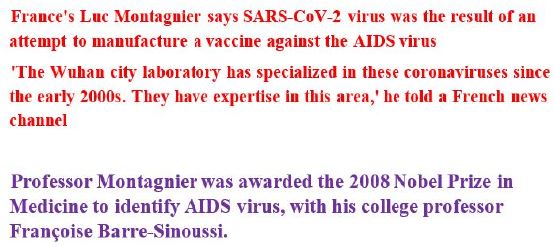
PubMed Articles
N Engl J Med., APRIL 22, 2004
Laboratory-acquired severe acute respiratory syndrome
PL Lim et al
The proximal origin of SARS-CoV-2
KG Andersen et al
Nature FEBRUARY 3, 2020
J Virol., MARCH 17, 2020
Y Wan et al
Recently, a novel coronavirus (2019-nCoV) has emerged from Wuhan, China, causing symptoms in humans similar to those caused by severe acute respiratory syndrome coronavirus.
Glycobiology JULY 1, 2018
Global aspects of viral glycosylation
I Bagdonaite et al
Enveloped viruses surround some of the most common human pathogens that cause infections of varying severity, ranging from nasal or very few symptoms to fatal diseases, as seen with viral hemorrhagic fever. All enveloped viruses have an envelope membrane that originates in the host cell, and is differentiated with virally encoded viral glycoproteins that are heavily encoded, important for infection, viral particle formation, and vaccine evasion. While N-linked glycosylation of viral envelope proteins is well characterized relative to site, structure, and site occupancy, the information on mucin-type O-glycosylation of these proteins is less comprehensive. In most cases, the process of viral glycosylation was investigated. Such research work is usually limited to the analysis of recombinant proteins produced in rows of cells with a different glycosylation capacity than that of the host cells. Therefore, the recombinant glycoproteins' glycosylation pattern may be different from the pattern in local viral proteins. In this letter, we provide a historical perspective on the analysis of viral glycosylation and summarize the known roles of glycans in the biology of enveloped human viruses. In addition, we describe how to overcome the analytical limitations by using a global approach based on mass spectrometry to detect O-glycosylation in lysates of virus-infected cells using a type 1 herpes simplex virus as a model. We emphasize that glycans often make important contributions to overall protein structure, immune function, and identification and that glycans are a crucial factor in shaping the vaccine. Analyzing high-yield glycosylation in relevant glycoprotein preparations and data collection and sharing, it is therefore important to identify glycosylation patterns in consensus for translation applications.
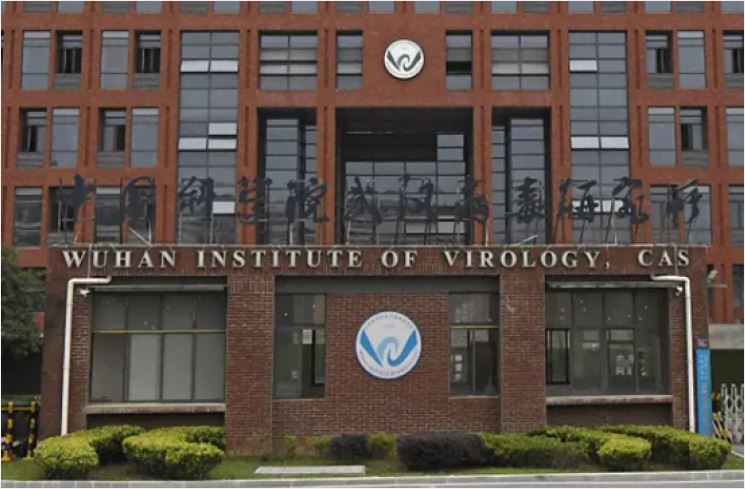
A May 20, 2020, photo of the Wuhan Institute of Virology in Wuhan, where research on bat coronaviruses was conducted. (Photo by Kyodo News via Getty Images) (credit ref. [7])
The COVID-19 epidemic has disrupted life around the world for more than a year. Its death toll will soon reach three million people. However, the source of the epidemic remains uncertain: the political agenda of governments and scientists has created thick clouds of haze, which the central press seems helpless to dispel. Next I will believe the existing scientific facts, which have many clues as to what happened, and I will bring to the readers the evidence for making their own decisions. I will then try to assess the complex issue of guilt, which begins in the Chinese government but is much broader. But science cannot be avoided because at the moment, and probably for a long time, it is offering the only safe thread through the maze.
Despite President Trump's statements [8,9] that the coronavirus was released from a laboratory in Wuhan, scientist say the evidence points to a natural origin.
The State Department said Friday that it had new information indicating that the COVID-19 epidemic could have come out of a Chinese lab rather than through contact with infected animals, the latest in the Trump administration's efforts to pressure Beijing because of the virus' origin. Specifically, the U.S. announced it had obtained new evidence that researchers at the Wuhan Institute of Virology contracted in the fall of 2019, before the first case of the outbreak in the surrounding city was identified, with symptoms it said matched COVID-19. Or common seasonal illnesses.
Now, U.S. President Joe Biden [10] has announced an urgent investigation that will test the theory as a possible source of the disease. So what do we know about competing theories - and why is the discussion meaningful?
A new wave of interest has resurfaced in laboratory leak theory. While the resurgent chatter may offer new clues or proof, the opposite is actually true. The continued lack of convincing evidence for or against the theory prompted calls for further investigation. President Biden said on Wednesday that the American intelligence community "does not believe there is enough information" to fully understand the likelihood of various scenarios explaining the origin of the virus that causes COVID-19.
It is suspected that the coronary virus may have escaped, accidentally or otherwise, from a laboratory in the
city of Wuhan in central China, where the virus was first isolated. Those who support the theory claim that
it could have leaked from this facility and spread to the animal market. Most of them claim that it was an
unchanged virus collected from nature and not engineered. The controversial theory first appeared at the
beginning of the plague and was promoted by then-US President Donald Trump. Some even suggested
that it could have been designed as a potential biological weapon. While many in the media and politics
dismissed them as conspiracy theories at the time, others called for more consideration of the possibility.
Nevertheless, the idea has resurfaced in recent weeks.
What do Scientists Think?
The issue is still hotly debated.
A World Health Organization (WHO) investigation was supposed to get to the bottom of it, but many experts believed it produced more questions than answers.
A team of scientists appointed by the World Health Organization flew to Wuhan earlier this year to investigate the source of the epidemic. After spending 12 days there, which included a visit to the lab, the team concluded that the lab leak theory was "improbable. "But many have since questioned their findings. A prominent group of scientists criticized the World Health Organization report for not taking the theory of laboratory leakage seriously enough - it was dismissed several pages from a report of several hundred pages.
"We must take speculation about natural flow and both laboratory flow seriously until we have enough data," the scientists wrote in the scientific journal.
And there is a growing consensus among experts that the laboratory leak should be closely examined.
Even the director general of the World Health Organization himself, Dr. Tedros Adhanum Gribrisus, called for a new inquiry, saying: "All hypotheses remain open and require further research." And Dr. Pausi now says he is "unconvinced" that the virus originated naturally. This is a change from a year ago, when it was likely that COVID spread from animals to humans.
Different viruses cause Mayocarditis on the heart muscle, and accumulating evidence links the heart muscle of a virus to the eventual development of extensive cardiomyopathy. The importance of hepatitis C virus infection in patients with dilated cardiomyopathy has recently been noted. The cytokines are increasingly recognized as an important factor in the pathogenesis and pathophysiology of myocarditis and cardiomyopathy. Increased circulating cytokines reported in patients with heart failure, and various cytokines have been shown to inhibit heart contraction in vitro and in vivo. Several recent studies have shown that cytokines produced by activated immune cells cause an increase in NO (nitric oxide) through the induction of NO synthase. Increased production of NO can lead to adverse entropy and damage to the heart muscle [12].
The late symptoms of COVID-19 (Credit ref. [13])
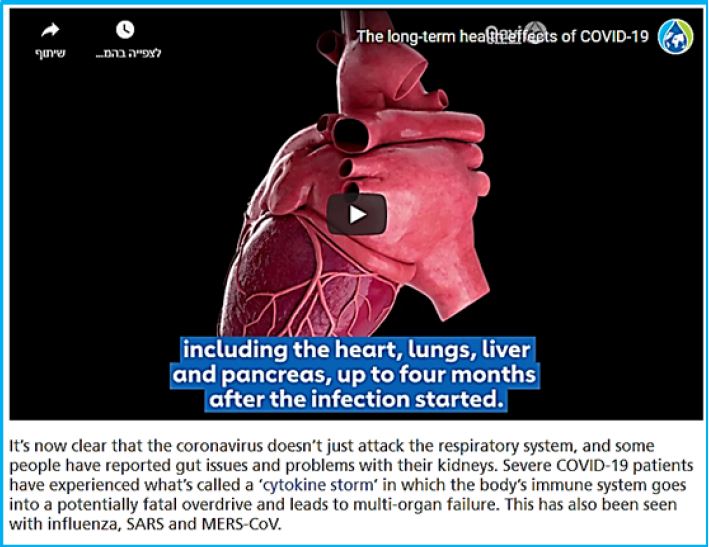
Severe acute respiratory distress syndrome (SARS), a coronary virus that appeared in 2003, causes symptoms very similar to COVID-19. As with COVID-19, people over the age of 60 are at the highest risk for severe symptoms. A study on the long-term effects of SARS in Hong Kong showed that two years after she contracted the disease, one in two SARS survivors had much better physical fitness and health status than those who had never had the disease. Only 78% of SARS patients were able to return to full-time work one year after infection. Another study, also conducted in Hong Kong, found that 40% of people who recovered from SARS still suffer from chronic fatigue symptoms 3.5 years after being diagnosed. Viral infections like SARS and Epstein-Barr virus are known to trigger chronic fatigue syndrome that can last for months or years.
Because we are still in the midst of an epidemic, and at a relatively early stage of a new disease, it is too early to say what COVID-19 survivors may experience in a year.
However, there are researchers who fear that just like in SARS, many people suffering from the new corona virus will continue to develop post-viral chronic fatigue syndrome. Future uncertainty for COVID-19 survivors is why a number of long-term follow-up studies (investigating genetic and environmental factors in large groups over time) have been returned to study the physical, mental, and socioeconomic consequences of an epidemic.
Should Children and Teens Be Vaccinated Against Coronary Heart Disease?
01/06/2021
Corona virus vaccines have the potential to protect many and bring us all back to a blessed routine. My opinion about adult vaccines is solid and can be read in the chapter that discusses corona vaccines at length.
In mid-January, the Ministry of Health also recommended vaccinating adolescents aged 16 and over with the Pfizer vaccine (the Modern Society vaccine is approved for ages 18 and older only). The people of Israel voted with their feet and many of the youth at these ages have already been vaccinated.
In early April, Pfizer's research data on children aged 12-16 were also published in the media.
On 13/04/21, a position paper was published on behalf of two highly respected and serious associations - the Association of Pediatrics and the Israeli Department of Infectious Diseases in Children. This paper also emphasizes the importance of vaccinating young children against corona.
On 10/05/21, the FDA approved the vaccine with an emergency permit at this age as well, and I assume that the vaccine will soon be approved by the Israeli Ministry of Health.
In many homes in Israel, the question arises as to whether to vaccinate the children and starting at what age.
In Favor of Corona Vaccination for Children Aged 12 and Over
Direct protection of the vaccinated - although there is no severe illness in children at these ages, here and there are those who suffer from a mild disease and more rarely - also from later complications (post-corona
syndrome or long corona syndrome). Therefore, vaccinating teens will protect them from the disease and its
complications. Keep in mind that some suffer from chronic diseases among teens that put them at higher
risk for coronary heart disease. These are children who can "enjoy" the vaccine more on a personal level.
Protecting the vaccinated environment - Vaccination of adolescents will help stop the current epidemic. At the family level - a vaccinated child will not catch on whether his grandmother is vaccinated or not. And at the national level - another part of the population will be vaccinated and probably less contagious. This means that at the national level, vaccination of any age group is welcome.
Bibliography
a. Shimon Shatzmiller*, Galina Zats, Inbal Lapidot & Rami Krieger (2020). The Role of Cytokins in Some Viral Infectious Diseases. Acta Scientific Neurology, 3(10), 69-71.
b. Shimon Shatzmiller (2020). Acceleration in COVID 19 Spreading. Genetics and Molecular Biology Current Research.
c. Shimon Shatzmiller*, Inbal Lapidot, Galina Zats & Rami Krieger. EXTENDED Palliative (compassionate) medicines for COVID-19. Medical & Clinical Research, 5(8), 48-55.
d. Shimon Shatzmiller* Galina Zats, Inbal Lapidot, Ludmila Buzhansky and Rami Krieger (2020). The “Kawasaki -like” syndrome in children - a further development of COVID 19? Medical & Clinical Research, 5(6), 107-109.
e. Shimon Shatzmiller*, Inbal Lapidot, Rami Krieger, Galina Zats and Ludmila Buzhansky (2021). Universal Vaccines: Science is Shifting to One for Many Opinions. Annals of Clinical Medicine and Research, 2(3), 1030.
f. Shimon Shatzmiller* and Inbal Lapidot (2020). New Information Revealed about the Trial of the Discontinued Vaccine Astrazeneca-Oxford Project. Losing Hopes. Archives of Health Science, 4(1), 1-12.
g. Shimon Shatzmiller*, Inbal Lapidot, Rami Krieger and Galina Zats (2020). Combast with SARS-COV-2 Virus, COVID-19 Pandemic. Medical & Clinical Research, 5(10), 78-80.
h. Shimon Shatzamiller*, Inbal Lapidot, Galina Zats & Rami Krieger (2021). The new “New York Mutation” - the new form of the Devil. Medical & Clinical Research, 6(3), 455-460.
i. Ashifa Trivedi, Sadhna Sharma & Blend Ashtey (2020). Investigational treatments for COVID-19. The Pharmaceutical Journal.

Hi!
We're here to answer your questions!
Send us a message via Whatsapp, and we'll reply the moment we're available!